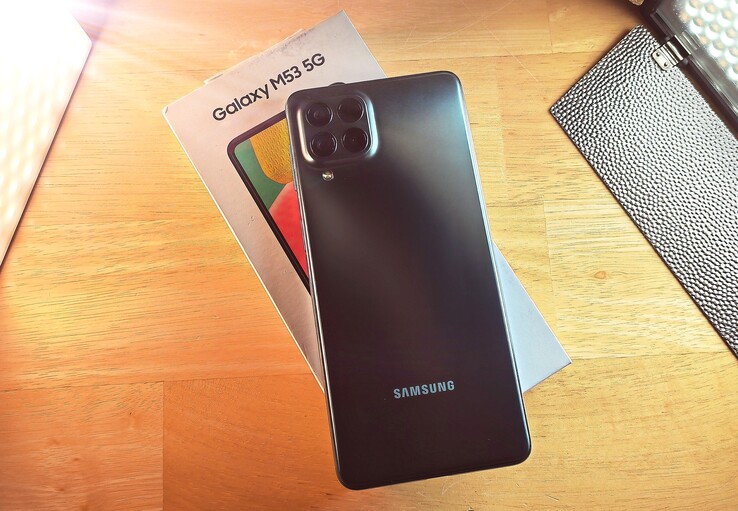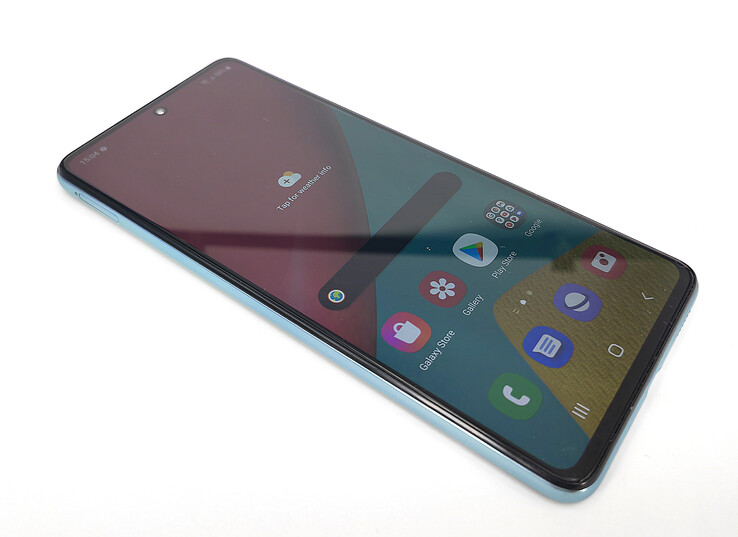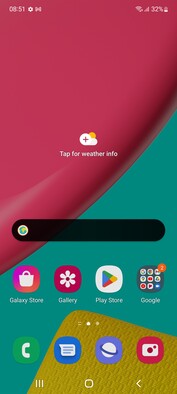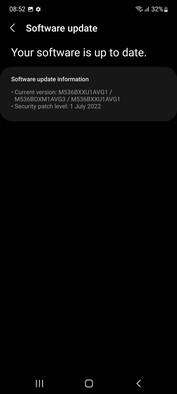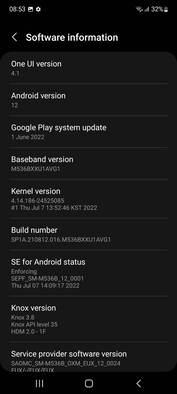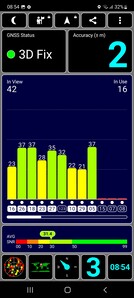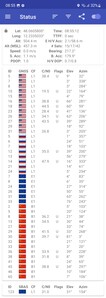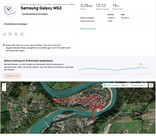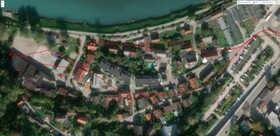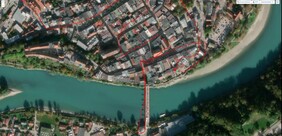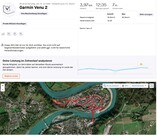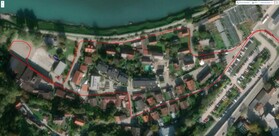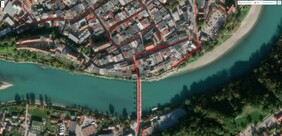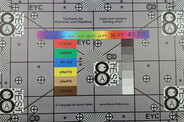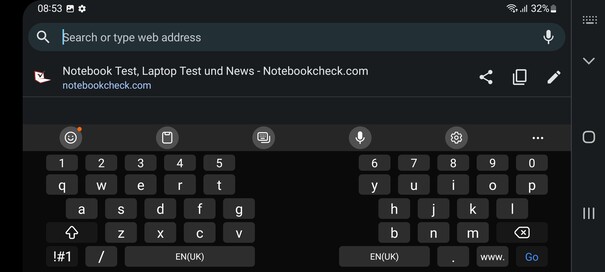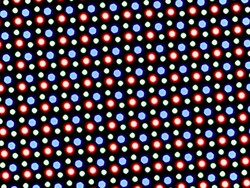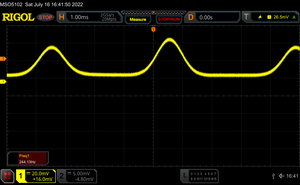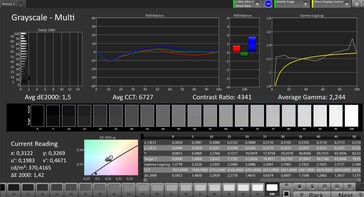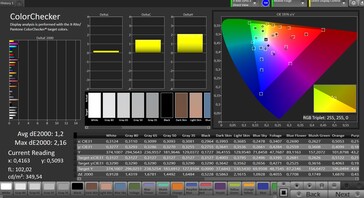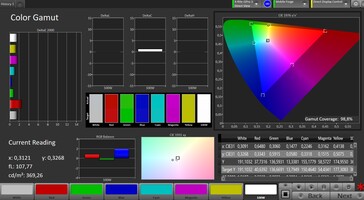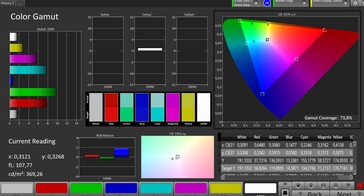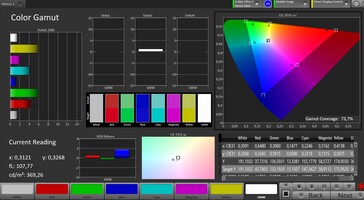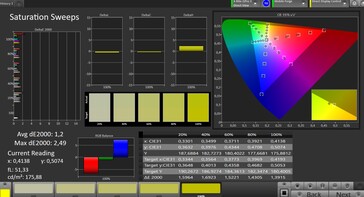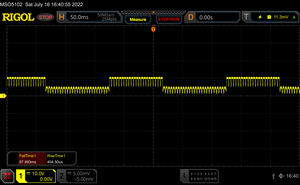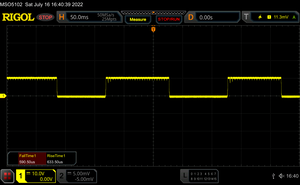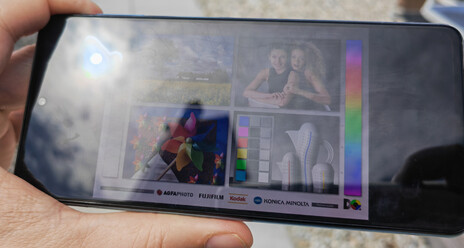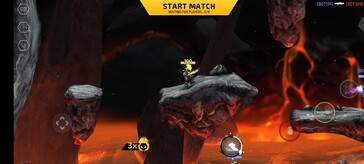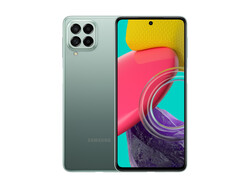Samsung Galaxy M53 5G smartphone review: Mid-range phone with orientation problems
For a few years now, Samsung has had two mid-range lines with the A series and the M series, and there's even a third line in some countries with the F series. In Central Europe at least, the M series is the more exclusive series, which isn't available everywhere and also offers a larger battery for less money.
The Samsung Galaxy M53 5G is intended to be the sweet spot of mid-range price, decent performance, high-quality display and good camera. In the process, it competes against strong rivals like the Galaxy A53 or the OnePlus Nord 2T.
Possible contenders in comparison
Rating | Date | Model | Weight | Drive | Size | Resolution | Price |
|---|---|---|---|---|---|---|---|
| 84 % v7 (old) | 08 / 2022 | Samsung Galaxy M53 5G Dimensity 900, Mali-G68 MP4 | 176 g | 128 GB UFS 2.1 Flash | 6.70" | 2408x1080 | |
| 83.4 % v7 (old) | 06 / 2022 | Samsung Galaxy A53 Exynos 1280, Mali-G68 MP4 | 189 g | 128 GB UFS 2.1 Flash | 6.50" | 2400x1080 | |
| 85.6 % v7 (old) | 07 / 2022 | Nothing Phone (1) SD 778G+ 5G, Adreno 642L | 193.5 g | 256 GB UFS 3.1 Flash | 6.55" | 2400x1080 | |
| 86.4 % v7 (old) | 07 / 2022 | Motorola Edge 30 SD 778G+ 5G, Adreno 642L | 155 g | 128 GB UFS 3.1 Flash | 6.50" | 2400x1080 | |
| 85.4 % v7 (old) | 06 / 2022 | OnePlus Nord 2T Dimensity 1300, Mali-G77 MP9 | 190 g | 256 GB UFS 3.1 Flash | 6.43" | 2400x1080 |
Case – The Galaxy M53 is large but light
The Galaxy M53 5G adheres to the current design line of the M series, featuring a matte, slightly iridescent plastic back. Blue, green and brown are available as colors, with the side frame also showing the corresponding color. The phone's front presents clearly visible display bezels and a punch-hole camera that is centered in the display's upper area. Overall, the design doesn't look as unified as that of the Galaxy A53, and Samsung doesn't provide any information on the protective glass or the resistance to water and dust contact for the M model.
Due to the 6.7-inch screen, you have to deal with a slightly wider and longer case with the Galaxy M53 compared to the competition. On the other hand, its weight of 176 grams can even beat most smartphones in its price range.
With the Galaxy M53, Samsung has created a solidly manufactured smartphone with smooth material transitions and a very stable chassis that can hardly be twisted.
Connectivity – Slow storage type
Samsung offers the Galaxy M53 5G with 128 GB of storage and 6 GB of RAM in Europe at an MSRP of 469 Euros (~$478). In other regions of the world, there's also a version with 8 GB of RAM.
However, Samsung only makes use of UFS 2.1 storage. It isn't quite as fast as UFS 3.1, which is used in the OnePlus Nord 2T, for example.
NFC and modern Bluetooth 5.2 are on board.
microSD card reader
There's a microSD reader, but its use blocks one of the two SIM slots. The Galaxy M53's card reader proved to be pretty fast in our test with our reference microSD card, the Angelbird AV Pro V60.
| SD Card Reader - average JPG Copy Test (av. of 3 runs) | |
| Samsung Galaxy M53 5G (Angelbird V60) | |
| Samsung Galaxy A53 (Angelbird V60) | |
Cross Platform Disk Test (CPDT)
Software – Up-to-date patches, a lot of bloatware
OneUI 4.1 is based on Android 12, and it's actually equipped with the latest security updates from July 2022 at the time of testing. Samsung promises quarterly patches for the smartphone, but the manufacturer hasn't provided any concrete information regarding the time frame for these updates or how many operating system upgrades the Galaxy M53 5G will receive.
Although Samsung has installed quite a few third-party apps on the phone, they can be uninstalled quite easily for the most part.
Communication and GNSS – Wi-Fi lags behind
The smartphone supports Wi-Fi 5 and is therefore much slower than the Nothing Phone (1) or the Motorola Edge 30, for example, both of which support the fast Wi-Fi 6E with access to the rarely used 6 GHz band in this price range. The OnePlus Nord 2T still supports Wi-Fi 6 and is also considerably faster as a result.
Wi-Fi speeds should be sufficient for everyday use; ultimately, all rates are well above the 300 Mb/s mark. This means that only the owners of Internet connections of 500 or 1,000 Mb/s can actually push the smartphone to its limits, but the communication within the Wi-Fi network might be a bit slower, such as when streaming content from a mobile phone to a TV set.
In terms of mobile networks, the Galaxy M53 comes with 5G, and it supports so many 4G frequencies that it can also be used for mobile Internet access on many international trips. We checked the reception randomly several times during our test. The result: The Galaxy M53 offers decent signal strength, but it isn't perfect, either. For example, one or the other reception bar quickly disappears from the display indoors.
| Networking | |
| iperf3 receive AXE11000 | |
| Average of class Smartphone (52 - 1857, n=182, last 2 years) | |
| OnePlus Nord 2T | |
| OnePlus Nord CE 2 5G | |
| Samsung Galaxy A53 | |
| Samsung Galaxy M53 5G | |
| iperf3 transmit AXE11000 | |
| OnePlus Nord 2T | |
| Average of class Smartphone (49.8 - 1828, n=182, last 2 years) | |
| OnePlus Nord CE 2 5G | |
| Samsung Galaxy M53 5G | |
| Samsung Galaxy A53 | |
| iperf3 transmit AXE11000 6GHz | |
| Average of class Smartphone (508 - 1945, n=96, last 2 years) | |
| Motorola Edge 30 | |
| Nothing Phone (1) | |
| iperf3 receive AXE11000 6GHz | |
| Average of class Smartphone (451 - 1870, n=96, last 2 years) | |
| Motorola Edge 30 | |
| Nothing Phone (1) | |
All the major satellite systems used for tracking are supported, as is the SBAS support system, which increases accuracy. So it's not surprising that the phone provides a location with an accuracy of 2 meters shortly after stepping outdoors. In turn, the variety and connection quality of the satellites found is below average.
This might also be the reason why the Galaxy M53 5G fails in our real-world tracking test: Nearly none of the routes we took were mapped correctly, while the Garmin Venu 2, which we took with us for comparison, only had minimal problems locating the route. We would therefore not recommend the Galaxy M53 as a navigation device. The manufacturer might be able to correct this with a software update.
Telephone and call quality – Clear communication
The Galaxy M53 5G uses Samsung's own phone app. It provides all important functions, but it can also be replaced by other apps from the Google Play Store if you don't like it.
We made a few test calls with the Galaxy M53 5G, and we found that the internal earpiece and the microphones do a good job: Sound is quite clean, and the person on the other end of the line usually understands us, even when we speak more quietly. However, we can't be too quiet when using the speaker and hands-free microphone, otherwise our voice doesn't reach the other person.
Cameras – Many lenses with decent quality
The Samsung Galaxy M53 5G's main camera is powered by the manufacturer's Isocell HM6 sensor that offers a lush 108 megapixels. Although pictures can also be taken in full resolution, the camera combines 9 pixels into one pixel by default, resulting in 12-megapixel pictures with increased light sensitivity.
Indeed, the illumination and brightening of the images is quite good, but the camera has serious issues with its autofocus at low light levels. Moreover, details are hardly visible in very dark areas.
Videos can be recorded in 4K and 30 fps at most. This puts the Galaxy M53 on par with its class. The autofocus doesn't pulsate, but it needs a second now and then to lock on to a new focus target. You can also switch to the wide-angle lens while recording in Full HD.
The wide-angle camera with a Sony IMX 355 and an 8-megapixel resolution takes decent snapshots, but you shouldn't magnify them too much since detail reproduction is lacking. There's no hybrid zoom between the wide-angle and main cameras in photos, either, and you can only switch directly between the lenses.
Also available are a low-resolution macro camera for extreme close-ups and an auxiliary lens for blur effects.
A 32-megapixel camera sensor is found at the front; it also uses pixel binning, which usually results in 8-megapixel shots. In general, pictures are quite appealing in good light, but they could be brightened a bit better in dark environments.
Image comparison
Choose a scene and navigate within the first image. One click changes the position on touchscreens. One click on the zoomed-in image opens the original in a new window. The first image shows the scaled photograph of the test device.
Main camera - FlowerMain camera - SurroundingsMain camera - Low lightWide-angle cameraIn the lab under specified lighting scenarios, we make our final verdict on the Galaxy phone's main camera: We determine that the general sharpness is at a medium level and that it sometimes decreases significantly towards the edges. At the same time, the contrast of the pictures is quite good. The imaging performance declines considerably in low light, but the subject remains recognizable.
This is a camera that should satisfy medium demands, but you'll have to pay more for absolute high-end mobile photography.
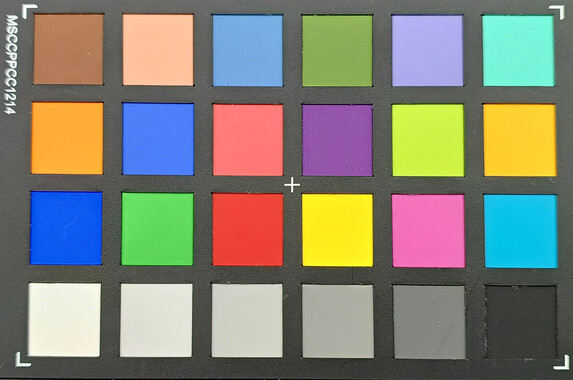
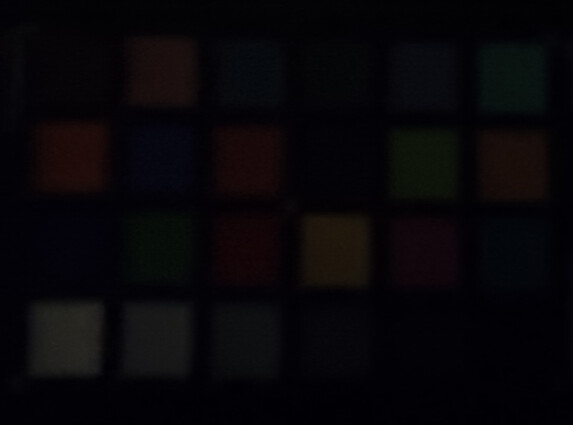
Accessories and warranty – The Galaxy M53 comes without a charger
The Galaxy M53 5G doesn't come with a power adapter, but only with a USB-C to USB-C cable and a SIM tool. Samsung doesn't offer any special accessories for the Galaxy M53 5G on its website. A compatible fast charger can be purchased from the phone manufacturer for approximately 50 Euros (~$51).
Samsung offers a 24-month warranty, as well as good service with fixed repair prices and many service centers in larger cities.
Input devices and handling – The fingerprint scanner unlocks the phone immediately
The 120 Hz display facilitates smooth animations, and it also gives the user a smoother experience. The touchscreen offers a pleasant surface, and it can also be used accurately in the corners.
The fingerprint sensor is integrated into the slightly recessed standby button located on the case's right side. We found its placement to be slightly too low for our hands and thought that it could be placed in a way that makes it easier to find. However, once you get used to it, it unlocks the smartphone immediately when you touch it with a registered finger.
Facial recognition is also available, but this is only a somewhat insecure 2D software solution.
Display – Bright and accurate OLED with PWM
The Galaxy M53 5G display's extended Full HD resolution is on par with its class. On the other hand, the AMOLED display performs very well in terms of maximum brightness: We measure 734 cd/m² on average in our tests with the spectrophotometer and the CalMAN software.
We observe that the display exhibits noticeable PWM flickering. The quick on and off switching of the display is especially used in OLED panels to reduce brightness, and it can lead to headaches in sensitive users. We can't find a DC dimming option that could mitigate this effect in the settings.
| |||||||||||||||||||||||||
Brightness Distribution: 91 %
Center on Battery: 745 cd/m²
Contrast: ∞:1 (Black: 0 cd/m²)
ΔE ColorChecker Calman: 1.2 | ∀{0.5-29.43 Ø4.78}
ΔE Greyscale Calman: 1.5 | ∀{0.09-98 Ø5}
98.8% sRGB (Calman 2D)
Gamma: 2.244
CCT: 6727 K
| Samsung Galaxy M53 5G Super AMOLED, 2408x1080, 6.7" | Samsung Galaxy A53 AMOLED, 2400x1080, 6.5" | Nothing Phone (1) OLED, 2400x1080, 6.6" | Motorola Edge 30 AMOLED, 2400x1080, 6.5" | OnePlus Nord 2T AMOLED, 2400x1080, 6.4" | |
|---|---|---|---|---|---|
| Screen | -28% | -8% | -30% | -87% | |
| Brightness middle (cd/m²) | 745 | 718 -4% | 620 -17% | 632 -15% | 561 -25% |
| Brightness (cd/m²) | 734 | 730 -1% | 625 -15% | 630 -14% | 573 -22% |
| Brightness Distribution (%) | 91 | 92 1% | 98 8% | 92 1% | 96 5% |
| Black Level * (cd/m²) | |||||
| Colorchecker dE 2000 * | 1.2 | 1.62 -35% | 1.24 -3% | 1.46 -22% | 2.67 -123% |
| Colorchecker dE 2000 max. * | 2.16 | 4.21 -95% | 2.31 -7% | 3.32 -54% | 6.15 -185% |
| Greyscale dE 2000 * | 1.5 | 2 -33% | 1.7 -13% | 2.6 -73% | 4.1 -173% |
| Gamma | 2.244 98% | 2.156 102% | 2.318 95% | 2.209 100% | 2.245 98% |
| CCT | 6727 97% | 6545 99% | 6325 103% | 6755 96% | 7104 91% |
* ... smaller is better
Screen Flickering / PWM (Pulse-Width Modulation)
| Screen flickering / PWM detected | 244 Hz | ||
The display backlight flickers at 244 Hz (worst case, e.g., utilizing PWM) . The frequency of 244 Hz is relatively low, so sensitive users will likely notice flickering and experience eyestrain at the stated brightness setting and below. In comparison: 53 % of all tested devices do not use PWM to dim the display. If PWM was detected, an average of 8111 (minimum: 5 - maximum: 343500) Hz was measured. | |||
Series of measurements with fixed zoom level and different brightness settings
The display's color reproduction is very accurate when the "Natural" color mode is selected: In this case, color tones and grayscale levels are brought onto the screen only with a minimal deviation from the reference color space. There's no blue tint in the grayscale that can be perceived with the naked eye, either.
The display's response times are very fast and therefore also very suitable for gamers with high requirements.
Display Response Times
| ↔ Response Time Black to White | ||
|---|---|---|
| 0.5 ms ... rise ↗ and fall ↘ combined | ↗ ms rise | |
| ↘ ms fall | ||
| The screen shows very fast response rates in our tests and should be very well suited for fast-paced gaming. In comparison, all tested devices range from 0.1 (minimum) to 240 (maximum) ms. » 1 % of all devices are better. This means that the measured response time is better than the average of all tested devices (20.2 ms). | ||
| ↔ Response Time 50% Grey to 80% Grey | ||
| 1.2 ms ... rise ↗ and fall ↘ combined | ↗ ms rise | |
| ↘ ms fall | ||
| The screen shows very fast response rates in our tests and should be very well suited for fast-paced gaming. In comparison, all tested devices range from 0.165 (minimum) to 636 (maximum) ms. » 4 % of all devices are better. This means that the measured response time is better than the average of all tested devices (31.6 ms). | ||
The high brightness also enables outdoor use. Naturally, though, there are reflections on the display, and you should rather withdraw into the shade when in direct sunlight.
Thanks to the OLED technology, the viewing angles are very good: Even when you look at the screen from the side, you see a virtually unaltered picture.
Performance – You can get more elsewhere
With the MediaTek Dimensity 900 as SoC, the Galaxy M53 performs at a slightly higher level than the Galaxy A53, but it's still clearly behind other phones in its price range in most benchmarks: Users get 20% to 40% less performance than with the Motorola Edge 30, for example, depending on the scenario.
The system generally runs smoothly, but there's slight stuttering when several demanding apps are running in the background. Nevertheless, the smartphone can still be used well. Other phones in this price range also offer more in terms of graphics performance.
| AImark - Score v2.x | |
| OnePlus Nord 2T | |
| Samsung Galaxy M53 5G | |
| Average MediaTek Dimensity 900 (40983 - 42107, n=4) | |
| Nothing Phone (1) | |
| Motorola Edge 30 | |
| Samsung Galaxy A53 | |
| GFXBench (DX / GLBenchmark) 2.7 | |
| T-Rex Onscreen | |
| Nothing Phone (1) | |
| Motorola Edge 30 | |
| Samsung Galaxy M53 5G | |
| Samsung Galaxy A53 | |
| OnePlus Nord 2T | |
| 1920x1080 T-Rex Offscreen | |
| OnePlus Nord 2T | |
| Motorola Edge 30 | |
| Nothing Phone (1) | |
| Samsung Galaxy M53 5G | |
| Samsung Galaxy A53 | |
| GFXBench 3.0 | |
| on screen Manhattan Onscreen OGL | |
| Motorola Edge 30 | |
| Nothing Phone (1) | |
| Samsung Galaxy M53 5G | |
| OnePlus Nord 2T | |
| Samsung Galaxy A53 | |
| 1920x1080 1080p Manhattan Offscreen | |
| OnePlus Nord 2T | |
| Motorola Edge 30 | |
| Nothing Phone (1) | |
| Samsung Galaxy M53 5G | |
| Samsung Galaxy A53 | |
| GFXBench 3.1 | |
| on screen Manhattan ES 3.1 Onscreen | |
| Motorola Edge 30 | |
| Nothing Phone (1) | |
| OnePlus Nord 2T | |
| Samsung Galaxy M53 5G | |
| Samsung Galaxy A53 | |
| 1920x1080 Manhattan ES 3.1 Offscreen | |
| OnePlus Nord 2T | |
| Nothing Phone (1) | |
| Motorola Edge 30 | |
| Samsung Galaxy M53 5G | |
| Samsung Galaxy A53 | |
| GFXBench | |
| on screen Car Chase Onscreen | |
| OnePlus Nord 2T | |
| Motorola Edge 30 | |
| Nothing Phone (1) | |
| Samsung Galaxy M53 5G | |
| Samsung Galaxy A53 | |
| 1920x1080 Car Chase Offscreen | |
| OnePlus Nord 2T | |
| Motorola Edge 30 | |
| Nothing Phone (1) | |
| Samsung Galaxy M53 5G | |
| Samsung Galaxy A53 | |
| on screen Aztec Ruins High Tier Onscreen | |
| OnePlus Nord 2T | |
| Motorola Edge 30 | |
| Nothing Phone (1) | |
| Samsung Galaxy M53 5G | |
| Samsung Galaxy A53 | |
| 2560x1440 Aztec Ruins High Tier Offscreen | |
| Motorola Edge 30 | |
| Nothing Phone (1) | |
| Samsung Galaxy M53 5G | |
| Samsung Galaxy A53 | |
| OnePlus Nord 2T | |
| on screen Aztec Ruins Normal Tier Onscreen | |
| OnePlus Nord 2T | |
| Motorola Edge 30 | |
| Nothing Phone (1) | |
| Samsung Galaxy M53 5G | |
| Samsung Galaxy A53 | |
| 1920x1080 Aztec Ruins Normal Tier Offscreen | |
| OnePlus Nord 2T | |
| Nothing Phone (1) | |
| Motorola Edge 30 | |
| Samsung Galaxy M53 5G | |
| Samsung Galaxy A53 | |
The Galaxy M53 5G isn't as fast as similarly priced smartphones from other manufacturers when it comes to browsing the Internet, either, at least according to our benchmarks.
But of course, we also try it out in everyday use. The result: You often browse quite quickly with the Galaxy M53, but you occasionally wait for images to load when scrolling.
| Jetstream 2 - 2.0 Total Score | |
| Average of class Smartphone (23.8 - 387, n=154, last 2 years) | |
| Motorola Edge 30 (Chrome 102.0.5005.125) | |
| Nothing Phone (1) (Chrome 103) | |
| OnePlus Nord 2T (Chrome 102) | |
| Samsung Galaxy A53 (Chrome 101) | |
| Average MediaTek Dimensity 900 (50.5 - 77.5, n=4) | |
| Samsung Galaxy M53 5G (Chrome 103) | |
| Speedometer 2.0 - Result 2.0 | |
| Average of class Smartphone (15.2 - 643, n=128, last 2 years) | |
| Motorola Edge 30 (Chrome 102.0.5005.125) | |
| OnePlus Nord 2T (Chome 102) | |
| Nothing Phone (1) (Chome 103) | |
| Average MediaTek Dimensity 900 (49.5 - 55.1, n=4) | |
| Samsung Galaxy A53 (Chome 101) | |
| Samsung Galaxy M53 5G (Chome 103) | |
| WebXPRT 3 - Overall | |
| Average of class Smartphone (38 - 380, n=35, last 2 years) | |
| Motorola Edge 30 (Chrome 102.0.5005.125) | |
| Nothing Phone (1) (Chrome 103) | |
| Samsung Galaxy M53 5G (Chrome 103) | |
| Samsung Galaxy A53 (Chrome 101) | |
| Average MediaTek Dimensity 900 (65 - 71, n=4) | |
| OnePlus Nord 2T (Chrome 102) | |
| Octane V2 - Total Score | |
| Average of class Smartphone (2228 - 121337, n=201, last 2 years) | |
| OnePlus Nord 2T (Chrome 102) | |
| Motorola Edge 30 (Chrome 102.0.5005.125) | |
| Nothing Phone (1) (Chrome 103) | |
| Samsung Galaxy A53 (Chrome 101) | |
| Samsung Galaxy M53 5G (Chrome 103) | |
| Average MediaTek Dimensity 900 (2800 - 30485, n=6) | |
| Mozilla Kraken 1.1 - Total | |
| Average MediaTek Dimensity 900 (1658 - 28190, n=5) | |
| Samsung Galaxy M53 5G (Chrome 103) | |
| Samsung Galaxy A53 (Chrome 101) | |
| Nothing Phone (1) (Chrome 103) | |
| OnePlus Nord 2T (Chrome 102) | |
| Motorola Edge 30 (Chrome 102.0.5005.125) | |
| Average of class Smartphone (257 - 28190, n=156, last 2 years) | |
* ... smaller is better
Samsung equips the Galaxy M53 with UFS storage, but not in such an up-to-date version as other manufacturers, so the storage's speed can't keep up with other phones.
This might not be so noticeable during random accesses, but the speeds of the Nothing Phone (1), for example, are almost twice as fast during sequential reading and writing, which is particularly important when dealing with larger files.
| Samsung Galaxy M53 5G | Samsung Galaxy A53 | Nothing Phone (1) | Motorola Edge 30 | OnePlus Nord 2T | Average 128 GB UFS 2.1 Flash | Average of class Smartphone | |
|---|---|---|---|---|---|---|---|
| AndroBench 3-5 | -8% | 71% | 50% | 79% | -30% | 131% | |
| Sequential Read 256KB (MB/s) | 893.9 | 510.1 -43% | 1638 83% | 1514.62 69% | 1891.3 112% | 761 ? -15% | 2223 ? 149% |
| Sequential Write 256KB (MB/s) | 495.6 | 486.7 -2% | 1351.9 173% | 965.35 95% | 1300.6 162% | 296 ? -40% | 1838 ? 271% |
| Random Read 4KB (MB/s) | 210.3 | 229.9 9% | 240.6 14% | 241.72 15% | 235.8 12% | 154 ? -27% | 295 ? 40% |
| Random Write 4KB (MB/s) | 204.2 | 210.8 3% | 228.2 12% | 249.14 22% | 262.2 28% | 130.4 ? -36% | 335 ? 64% |
Games – The Galaxy phone makes gaming at 120 fps possible
When it comes to gaming, the Galaxy Phone is generally capable of making its 120 Hz display available for fast gaming frame rates: We easily reached around 110 fps in the fast shooter Armajet.
We also managed smooth frame rates in PUBG Mobile, but these are clearly below what the display is theoretically capable of at just under 60 fps on low details. We measured the fps rates with our partner GameBench's software.
Controlling the device using the touchscreen and position sensor works without issues.
Emissions – Good speaker
Temperature
A temperature increase of up to 44.7 °C (~112 °F) under prolonged load is definitely significant, and it could even become uncomfortable in high ambient temperatures.
However, the 3D Mark Wild Life stress tests show that this doesn't have an impact on the smartphone's performance, as it remains at roughly the same level even after numerous runs of the benchmark.
(±) The maximum temperature on the upper side is 43.7 °C / 111 F, compared to the average of 35.2 °C / 95 F, ranging from 21.9 to 247 °C for the class Smartphone.
(±) The bottom heats up to a maximum of 44.7 °C / 112 F, compared to the average of 34 °C / 93 F
(+) In idle usage, the average temperature for the upper side is 25.1 °C / 77 F, compared to the device average of 32.9 °C / 91 F.
3DMark Wild Life Stress Test
| 3DMark | |
| Wild Life Stress Test Stability | |
| Samsung Galaxy A53 | |
| Samsung Galaxy M53 5G | |
| Nothing Phone (1) | |
| Motorola Edge 30 | |
| OnePlus Nord 2T | |
| Wild Life Extreme Stress Test | |
| Motorola Edge 30 | |
| Nothing Phone (1) | |
| Samsung Galaxy M53 5G | |
| Samsung Galaxy A53 | |
| OnePlus Nord 2T | |
Speaker
The small mono speaker is located at the bottom edge of the phone; it produces a decent sound, and it even makes lower mids audible at times, while not exaggerating the high tones. Overall, it provides a decent volume and a fairly balanced sound that's quite suitable for listening to music from time to time.
Naturally, the speaker is usually unable to keep up with external headphones or speakers. These can be connected via USB-C or Bluetooth. When it comes to Bluetooth codecs, Samsung still has a hard time integrating the widely used aptX family. There's only basic support here, and the manufacturer relies instead on its own Scalable Codec.
Samsung Galaxy M53 5G audio analysis
(+) | speakers can play relatively loud (82.1 dB)
Bass 100 - 315 Hz
(-) | nearly no bass - on average 27.7% lower than median
(±) | linearity of bass is average (10.5% delta to prev. frequency)
Mids 400 - 2000 Hz
(±) | higher mids - on average 6.9% higher than median
(±) | linearity of mids is average (7.6% delta to prev. frequency)
Highs 2 - 16 kHz
(+) | balanced highs - only 3% away from median
(+) | highs are linear (6% delta to prev. frequency)
Overall 100 - 16.000 Hz
(±) | linearity of overall sound is average (23.3% difference to median)
Compared to same class
» 52% of all tested devices in this class were better, 7% similar, 41% worse
» The best had a delta of 11%, average was 35%, worst was 134%
Compared to all devices tested
» 69% of all tested devices were better, 5% similar, 26% worse
» The best had a delta of 4%, average was 24%, worst was 134%
Motorola Edge 30 audio analysis
(+) | speakers can play relatively loud (84.6 dB)
Bass 100 - 315 Hz
(-) | nearly no bass - on average 21.2% lower than median
(±) | linearity of bass is average (9.1% delta to prev. frequency)
Mids 400 - 2000 Hz
(±) | higher mids - on average 7.3% higher than median
(±) | linearity of mids is average (7% delta to prev. frequency)
Highs 2 - 16 kHz
(+) | balanced highs - only 2.5% away from median
(+) | highs are linear (3.6% delta to prev. frequency)
Overall 100 - 16.000 Hz
(±) | linearity of overall sound is average (18.6% difference to median)
Compared to same class
» 21% of all tested devices in this class were better, 9% similar, 70% worse
» The best had a delta of 11%, average was 35%, worst was 134%
Compared to all devices tested
» 41% of all tested devices were better, 8% similar, 51% worse
» The best had a delta of 4%, average was 24%, worst was 134%
Battery life – It could be fully recharged faster
Energy consumption
The Galaxy Phone is quite frugal under load, but it's a bit more power-hungry than comparable phones in idle usage. This might also be due to the larger display, which probably doesn't have that much of an impact under higher load.
The phone can be charged at a maximum of 25 watts. That's a relatively weak charging performance, and charging times of almost 2 hours aren't uncommon. On the other hand, the OnePlus Nord 2T charges super fast at 80 watts, while Motorola still charges at 33 watts in this class.
| Off / Standby | |
| Idle | |
| Load |
|
Key:
min: | |
| Samsung Galaxy M53 5G 5000 mAh | Samsung Galaxy A53 5000 mAh | Nothing Phone (1) 4500 mAh | Motorola Edge 30 4020 mAh | OnePlus Nord 2T 4500 mAh | Average MediaTek Dimensity 900 | Average of class Smartphone | |
|---|---|---|---|---|---|---|---|
| Power Consumption | -4% | 4% | 9% | 5% | -5% | -23% | |
| Idle Minimum * (Watt) | 1 | 0.9 10% | 1 -0% | 0.9 10% | 0.9 10% | 0.932 ? 7% | 0.848 ? 15% |
| Idle Average * (Watt) | 1.4 | 1.3 7% | 1.2 14% | 1.2 14% | 1.3 7% | 1.794 ? -28% | 1.434 ? -2% |
| Idle Maximum * (Watt) | 1.8 | 1.6 11% | 1.5 17% | 1.5 17% | 1.7 6% | 1.994 ? -11% | 1.618 ? 10% |
| Load Average * (Watt) | 4.2 | 5.7 -36% | 4.2 -0% | 3.6 14% | 4 5% | 3.95 ? 6% | 7.01 ? -67% |
| Load Maximum * (Watt) | 6.6 | 7.3 -11% | 7.4 -12% | 7.1 -8% | 6.8 -3% | 6.43 ? 3% | 11.3 ? -71% |
* ... smaller is better
Energy consumption: Geekbench (150 cd/m²)
Energy consumption: GFXBench (150 cd/m²)
Battery life
A 5,000 mAh battery is actually not that usual in this price range; manufacturers generally go for 4,500 mAh or even weaker batteries here. The larger battery is especially remarkable in view of the Galaxy M53 5G's relatively low weight.
The Galaxy Phone can definitely profit from this, and it achieves a runtime of 16:28 hours in our Wi-Fi test, which suggests that it can run for two days without charging during normal use. The phone has an advantage in the other scenarios as well. Only under very high load is it unable to reach the first place in the comparison field.
| Samsung Galaxy M53 5G 5000 mAh | Samsung Galaxy A53 5000 mAh | Nothing Phone (1) 4500 mAh | Motorola Edge 30 4020 mAh | OnePlus Nord 2T 4500 mAh | |
|---|---|---|---|---|---|
| Battery runtime | -11% | -17% | -26% | -11% | |
| Reader / Idle (h) | 42.7 | 40.5 -5% | 30.2 -29% | 26.7 -37% | 32.3 -24% |
| H.264 (h) | 23.8 | 19.1 -20% | 17.7 -26% | 16.7 -30% | 19.3 -19% |
| WiFi v1.3 (h) | 16.5 | 14.8 -10% | 15.4 -7% | 10.6 -36% | 15.8 -4% |
| Load (h) | 4.5 | 4.1 -9% | 4.3 -4% | 4.5 0% | 4.7 4% |
Pros
Cons
Verdict – Tracking issues are a clumsy mistake
The Samsung Galaxy M53 5G is a relatively lightweight and yet quite large mid-range phone with a generous battery capacity. It can't entirely keep up with other phones in its price range in some areas, such as performance, storage speed, or fast charging technology.
In return, however, the price has already dropped considerably at the time of testing, and you get a microSD slot to expand storage space, a sturdy case, and a pretty flexible camera that takes decent photos. The display is also a real highlight: Bright and with accurate colors as you would expect from a Samsung OLED. However, it also uses PWM flickering, and this can't be mitigated by a DC dimming mode.
With the Galaxy M53 5G, Samsung offers a compelling mid-range phone with a great display and good battery life. However, the inaccurate positioning is irritating.
What isn't acceptable at all are the constant and significant deviations in terms of positioning. Even if you only want to use the smartphone for occasional navigation, we wouldn't recommend it in its current state. The fact that no charger is included can be regarded positively or negatively, depending on whether you already have one at home.
Let's take one more look at the alternatives: The OnePlus Nord 2T is faster in everyday use and when charging. At the time of writing, you can get it for around $400 on Amazon. The Motorola Edge 30 impresses with its fast storage and a bright as well as even slightly faster display.
Price and availability
The Samsung Galaxy M53 isn't officially available in the United States, but you can keep an eye on online stores like Amazon to see when the device pops up.
Samsung Galaxy M53 5G
- 08/30/2022 v7 (old)
Florian Schmitt




